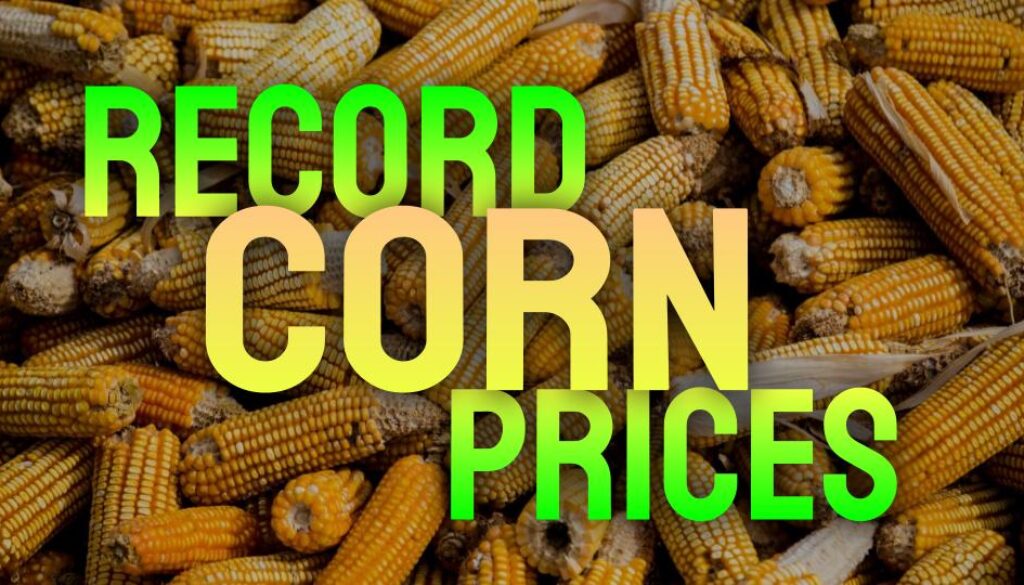Record Corn Prices and Grain Market Dynamics: An In-Depth Look at Current Trends

Corn prices have reached historic highs, with record prices dominating headlines in the grain industry. The surge in prices has left agricultural experts and producers alike analyzing the factors at play, ranging from adverse weather conditions to shifts in global demand. Insights from Matt Bennett, an expert with AgMarket.net, and Joe Vaclavik, the founder of Standard Grain and host of Grain Markets and Other Stuff, offer a closer look at the forces behind this market phenomenon.
Record Highs and the Impact on Producers
In a recent analysis, Matt Bennett explained that “corn prices are significantly higher than what we were seeing last year, and I think we can expect some continued strength moving forward.” He went on to emphasize that while the surge is driven by multiple factors, it is primarily tied to concerns over reduced supplies due to unfavorable weather, making these price levels likely to remain elevated in the near future.
Matt’s colleague, Joe Vaclavik, added his thoughts on the market, saying, “We are dealing with a very tight supply situation, and that’s what is fueling this increase in prices. The droughts across key growing regions are making things worse.”
Weather and Drought Conditions: A Key Factor
The weather is playing a critical role in the spike in corn prices. As the USDA’s weekly drought monitor reveals, large parts of the Midwest and Plains are experiencing dry conditions, which have placed significant stress on crops. As of the latest report, 54% of corn-growing regions are experiencing some level of drought. This lack of moisture, combined with limited precipitation in the forecast, has raised concerns about reduced yields in these key growing areas.
Matt Bennett discussed the current drought situation, highlighting, “The subsoil moisture is a real concern, and with little rainfall in the forecast, it’s hard to predict if we’ll see any relief soon.” Joe Vaclavik also noted that while weather-related price fluctuations are common, the “combination of a strong global demand for corn and tightening supplies due to weather conditions” is particularly alarming. He explained that drought conditions are exacerbating the supply crunch, further pushing prices to record levels.
Global Factors and Export Markets
Global demand is another significant driver behind the record corn prices. The United States, as a leading exporter of corn, is facing increased international competition from countries like Brazil and Ukraine. However, demand from major buyers like China continues to soar, adding to the market’s upward pressure. Grain Market and Stuff emphasized the impact of strong export demand, especially for animal feed and industrial use in China.
Joe Vaclavik pointed out, “The demand for U.S. corn from countries like China has been exceptional. Even with higher prices, these countries continue to buy, making corn a sought-after commodity worldwide.” With the U.S. facing tight domestic supplies, the global export market has intensified, contributing to the sharp rise in prices.
Challenges in the Cattle Industry: Feeding Costs Rise
Higher corn prices are also having a ripple effect on industries reliant on corn for animal feed, particularly cattle producers. Joe explained that “with rising corn prices, the cost of feeding cattle is going up, which will likely impact meat prices in the future.” This is creating additional challenges for livestock producers, who are seeing increased costs across the board.
Despite these challenges, Matt remains cautiously optimistic. He noted that “the wheat market, for example, is oversold right now, and there’s potential for a rally in wheat prices, which could help provide some stability to the broader grain market.” If this rally materializes, it could offer some relief to farmers facing higher input costs for their crops and livestock.
The Outlook for Corn and Grain Markets in 2024
As the U.S. enters 2024, the outlook for corn prices remains uncertain, with experts predicting continued volatility. Both Matt and Joe agree that the long-term trend points to sustained high prices, largely due to ongoing weather-related issues and continued strong global demand.
Looking ahead to the spring and summer of 2024, Matt Bennett is hopeful, stating, “We are heading into a critical period. As long as weather patterns remain stable and there is no drastic disruption in demand, corn prices should maintain their current strength.” Joe Vaclavik, however, urges caution and recommends that producers “stay protected against potential price fluctuations,” emphasizing the importance of hedging to manage risk effectively.
The market for corn, along with other grain markets, will continue to be shaped by weather patterns, demand from international markets, and the actions of domestic producers. As conditions evolve, farmers, traders, and analysts alike will need to remain vigilant to navigate this highly dynamic and volatile market.
At Control Chief Corporation, we are committed to providing cutting-edge solutions that enhance the efficiency and safety of industrial operations. Our locomotive remote controls are designed to improve the movement of locomotives in grain handling facilities, reducing labor costs and minimizing safety risks. As the grain industry navigates record prices and fluctuating markets, technologies like locomotive remote controls play a crucial role in ensuring that operations run smoothly and profitably. For more information on how we can help streamline your grain handling operations, reach out to our sales team.
Views: 12



